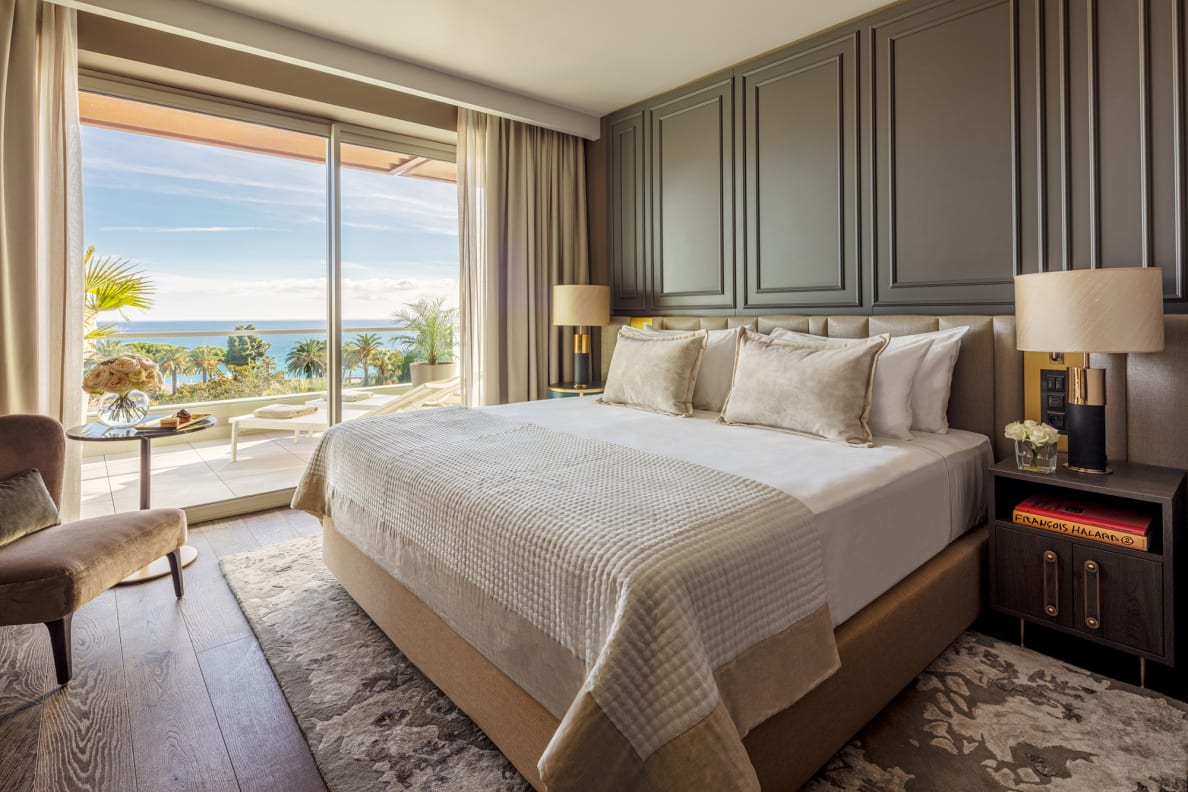Walking along the Promenade des Anglais today in Nice, you have to do a bit more than squint to imagine it as the stomping ground for aristocracy that it once was. A number of storied hotels have gone to seed, the traffic is relentless, and the crowd is, well, not exactly aristocratic. But stroll through the waterfront Jardin Albert 1er, and on the other side you’ll find a place where that pomp and glitz has been renewed. That spot, the Anantara Plaza Nice Hotel, is the latest selection for our column on exciting new hotels, Room Key.
The hotel is housed in a fanciful Belle Epoque edifice originally designed by the king of grand hotels in the south of France, Charles Dalmas. The mustard-yellow facade stretching more than a hundred meters has been restored to its frothy grandeur. Inside, though, is sharp and meticulous modern luxury. Mosaic floors line an arched hallway with textured iridescent walls leading to the hotel’s reception.
Just off the reception is one of the more elegant rooms we’ve come across of late, Les Colonnades. The Art Deco oval room with unadorned travertine columns is topped by a smooth cream-colored dome and oculus–an airy space redolent of the Session Hall in the Finnish Parliament. Here, the bit of pop comes from the curving couches upholstered in lush green velvet. The hotel’s high tea—the typical elaborate confection of cakes, bites, and bubbly done at old world hotels—takes place here. Otherwise, it’s often empty and quiet, so if you find the rooftop scene a bit much, squirrel away down here later at night for a more intimate scene.
The rooftop restaurant SEEN.
Daniela Cesarei
While the waterfront of Nice isn’t full on glamor, the city itself is a delight and was recently named a World Heritage Site. Awash in many-hued buildings from a half-dozen centuries, walking its winding streets is a must. The hotel is right in the heart of it all, with unobstructed views of the sea over the park from the top floors but also at the vanguard of one of France’s most liveable cities.
The bedrooms of the Anantara Plaza Nice Hotel are done in a modern luxury aesthetic–dark woods, gray unadorned paneled walls, marble bathrooms, but with balconies that bring in some of the hotel’s warm yellow exterior as well as the park across the street (or, if you’re on a higher floor, the sea). One of the benefits to the hotel being on the park and not the main drag is that there’s almost no car noise.

Daniela Cesarei
One place that does bring the noise, however, is the hotel’s buzzy rooftop restaurant, the latest outpost of SEEN by Olivier (after spots in Lisbon, São Paulo, and Bangkok). It’s done up in travertine, light woods, wisteria, and columns covered in opalescent tiles and features a menu fusing Niçoise cuisine with Asian influences. It does, however, become a scene at night, so if you’re sound-sensitive, don’t book a room on the floor right below it. Also, do try the hotel’s exclusive bottle from the Château de Crémat, it’s the perfect white for a city famed for its 300 days of sunshine. I’m tempted to call it a porch-pounder because it was so easy to drink, but this is France, so I’ll refrain.
Speaking of Château de Crémat, the medieval revival mansion up in the hills over the city is one of a number of experiences the hotel prides itself on arranging for visitors. While it’s understandable to think of the sea as Nice’s main draw, the surrounding hills actually hold its real gems, such as Saint Paul de Vence, Èze, and Vallauris.
One afternoon, the hotel took the group of journalists I was traveling with to Vallauris to showcase one of their excursions. The town was Pablo Picasso’s home at one point and the place where he pursued his passion for pottery. Dominique Sassi was just a young man when he was selected to be Picasso’s colorist in the late 1940s. His job was to help the master select paints that would achieve what he needed on the earthenware. Sassi, now in his late 80s, was our guide for the day. Bearing a striking resemblance to the painter in his later years, Sassi walked us through Picasso’s War and Peace mural which covers the arched vault attached to an ancient chapel. Then he guided us among the dozens of plates, vases, and decorative pottery held by the town’s museum—all of which he aided Picasso on. It was a surreal experience, one of those that allows you to create tangible human links that bring the past to the present. And while Sassi isn’t normally part of the hotel’s excursions, who knows, you just might luck out too.






